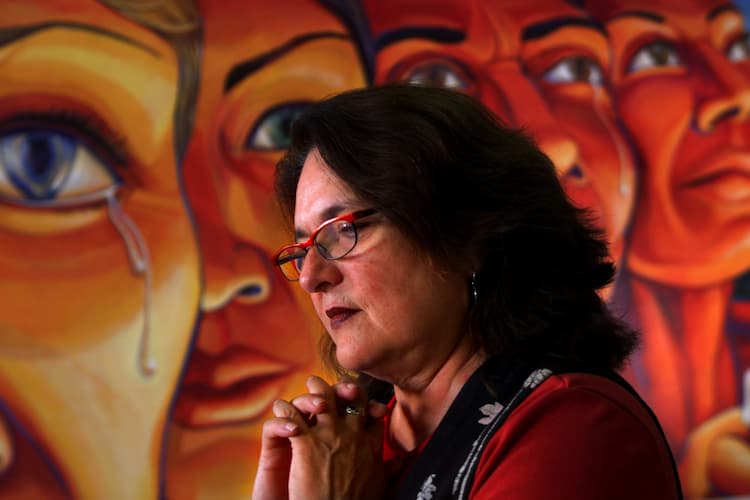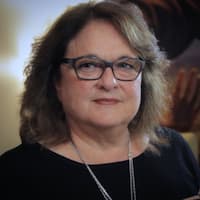Judy Baca Biography
Judy Baca is an American artist, activist, and University of California, Los Angeles professor of Chicano studies, world arts, and cultures. She is the artistic director and co-founder of the Social and Public Art Resource Center (SPARC) in Venice, California.
How old is Judy Baca? – Age
She is 77 years old as of 20 September 2023. She was born in 1946 in Huntington Park, California, United States. Her real name is Judith Francisca Baca.
Where is Judy Baca parents from? – Family
Baca was born on September 20, 1946, in Los Angeles, California, to Mexican American parents. She was up in Watts, Los Angeles, a mostly Black and Latino neighborhood. She grew up in an all-female household with her mother, aunts Rita and Delia, and grandmother Francisca. Her military father was unaware of her existence and relocated to the east coast shortly after her birth.
Her grandmother was a herbal healer and curanderismo practitioner, which greatly influenced her understanding of indigenous Chicano culture.
Baca’s mother later married Clarence Ferrari in 1952, and he has two half-brothers, Gary and Diane. Following that, the three of them relocated to Pacoima, Los Angeles. Pacoima was very different from Watts in that Mexican-Americans were the minority.
Judy Baca Education
Baca was not permitted to speak Spanish in primary school since it was illegal, but she did not speak English very well. While the other students were studying, the teacher would urge her to go paint in the corner. Baca improved in class after a while since she was able to understand the materials. She began drawing and painting with the help of her art teacher. In 1964, she graduated from Bishop Alemany High School.
She subsequently went on to California State University, Northridge (CSUN), where she received her bachelor’s degree in 1969 and her master’s degree in fine art in 1979. Judy was the first Baca to attend college, and she briefly dropped out after becoming bored of being poor. She looked for work in production illustration and stayed there until she was encouraged to return to college and earn a Bachelor of Fine Arts. She learned and studied modern abstract art while there. She desired to create art that was accessible outside of the confines of the gallery and the museum. She wanted to make work for the people she cared about, but she knew they didn’t frequent galleries. Baca continued her education after graduating from graduate school, studying muralism at Taller Siqueiros in Cuernavaca, Mexico.
Judy Baca Net Worth
He has an estimated net worth of $5 million.

Judy Baca Great Wall of Los Angeles – Mural
The Social and Public Workmanship Asset Center (SPARC) was established in 1976 by Judy Baca, Christina Schlesinger, and Donna Deitch. The creative heading was propelled by the possibility that expressions ought to focus ordinary individuals. The principal task of SPARC was the Incomparable Mass of Los Angeles, which planned to paint a background marked by Los Angeles, yet not the rendition found in history books. The wall painting was motivated by Los tres Grandes (“The Three Greats”), a clever around three compelling Mexican muralists: Diego Rivera, David Alfaro Siqueiros, and José Clemente Orozco.
Bacha started the venture with nine different craftsmen, five students of history, and 80 youngsters who had been alluded to the program by the law enforcement division. She zeroed in on putting resources into the local area in manners that had not been finished previously and affected individuals from all kinds of ages and foundations. She started to lead the pack on the task by meeting individuals about their lives, family backgrounds, lineage, and stories they heard from their more established family members, as well as counseling history specialists.
Bacha maintained that the venture should be finished by individuals who were just about as different as those to be painted, drawing on abilities not regularly utilized by specialists. By zeroing in on the cycle and including the local area in making public fine art that common the narratives of minimized individuals, she participated in an artivist project. Working with youngsters was significant for Baca on the grounds that she saw that a considerable lot of them engaged with packs were likewise utilizing spray painting to communicate their thoughts and guarantee an area.
Notwithstanding, Baca battled with how gendered muraling activities and spaces were. The greater part of the youngsters she worked with were young fellows, and there was aggression towards the possibility of ladies in broad daylight spaces and women’s activist standards. To resolve this issue, Baca effectively attempted to associate with other women’s activist craftsmen and enlist young ladies to partake in her muraling projects.
Toward the finish of the undertaking, the painting was estimated a portion of a mile long (2,754 feet) and gave more than 400 individuals business and initiative improvement potential to open doors. Albeit the wall painting presently gauges 2,754 feet long, it isn’t yet finished. The task is proposed to go on until it arrives at close to a mile, so it might depict contemporary times as well as a dream representing things to come.
Judy Baca Paintings
In 1987, craftsman Maria Baca started painting The World Wall: A Dream Representing things to come Unafraid, a dream of a world without viciousness. She looked for specialists from around the world to assist her with making the canvas, which was first presented in Finland in 1990. The undertaking was subsequently dispatched by Los Angeles Chairman Tom Bradley to make the Local Pride Program, which utilized more than 1,800 in danger youth and made north of 105 paintings all through the city. In 1996, Baca made La Memoria de Nuestra Tierra for the Denver Global Air terminal, expecting to recount the failed to remember accounts of individuals who traversed the land. The painting was finished in 2000.
Baca directed research on the historical backdrop of wall paintings in Los Angeles, tracking down an image of a gathering between Corky Gonzales and Cesar Chavez, which prompted the Delano grape strike. She talked at the “Against the Wall: The ruin and recharging of LA’s paintings” board and made the Cesar Chavez Landmark Curve of Poise, Balance, and Equity in 2000, which is situated at San Jose State College.
